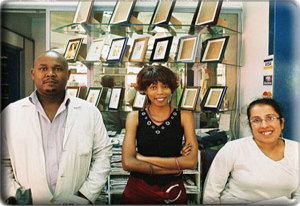grand merci! sans leur support et aide généreuse, wimbi n’aurait jamais pu arriver a ce stade-la.
je voudrais remercier tout le monde pour leur aide, leurs donations, et leur réductions de prix, leur patience, longues heures et postes de nuit, ainsi que leur amitié, écouté et confiance qu’ils ont montre dans moi et mes idées.
je voudrais aussi remercier les directeurs d'école, les professeurs et tous leurs collaborateurs, dans les écoles ou je travaillais, pour l'hospitalité et leurs conseils.
enfin, je voudrais vivement remercier tous mes étudiants pour le temps et l’effort dédiés au projet, pour leurs idées folles et drôles, et leur enthousiasme infatigable.
merci !
p.s.:
»merci beaucoup« to myriam baele for the french translation of these pages.
je voudrais remercier tout le monde pour leur aide, leurs donations, et leur réductions de prix, leur patience, longues heures et postes de nuit, ainsi que leur amitié, écouté et confiance qu’ils ont montre dans moi et mes idées.
je voudrais aussi remercier les directeurs d'école, les professeurs et tous leurs collaborateurs, dans les écoles ou je travaillais, pour l'hospitalité et leurs conseils.
enfin, je voudrais vivement remercier tous mes étudiants pour le temps et l’effort dédiés au projet, pour leurs idées folles et drôles, et leur enthousiasme infatigable.
merci !
p.s.:
»merci beaucoup« to myriam baele for the french translation of these pages.
special thanks to: phoebe akinyi • brian amuyunzu • andreas • michael atieri • tony ayiera • myriam und felix baele • mbanjwa bandlakazi • ralf beckamp • inge berger • bulelani bobotyana • nonkosi boyle • miss. v.m. budaza (maggie) • neil clayton • mohamed daoud • iain delaney • gerlinde dombrowski • christina gauding • melikoa gonqxoza • thumeka gwita • luke hefson • bettina helfenritter • johannes hossfeld • biko huester • paul hütte • joyce inziani • isaac • mark james • nolusindiso joja • jonathan • jill joubert • mafunda khuthala • alison kingsley-hall • peter kinyanjui • sr. leah • www.loghound.com • matyhintyala lihle • anthony macharia • francis maina • regula manser • nokubonga madyolo • nomuuzo makhonza • luvuyo mandyli • phikelemzi ceasar mashiya • salman matemba • tiny mathe • alice mbenyi • alfred mazaka • samkelele mbebe • lundi mbityana • andile mbobi • john mclaughlin • mendiswa • ntomboyse mgaba • mirella • janele mkhaba • monica • zaza msindise • elvis ndiki • lubabalo ndongeni • molukhanyo ngqeleni • nompumelelo nhebi • ann njambi • joseph njau • thozama nkgayi • thobela nkiwana • nobesuthu • mador nobomuu • falangile nozandine • siyo odwa • pravin patel • carolyn peters • irmingard pinske • gcobani potso • sarat pradhan • barbara reich • annika rudolph • stella rudolph • samuel • wolfgang sandig • stefan schaar • siegfried schmerbeck • andy schmitt :-) • monika schoeller • iris schürch • gabriele shettle • sidumo sibulelo • zoliswa silomo • rachna singh • collin stevens (und errol) • maike stoehr • roy tanck • thandisizwe (ta-charlie) • mbadambdna thando • miss tole • yaso vugokazi • wolfgang weber • hlobo xolelwa • ...













